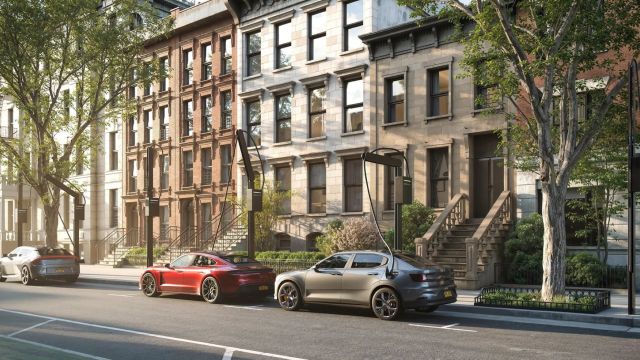
CHARGING 'TREES' COULD SOLVE CITIES' BIGGEST ELECTRIC CAR PROBLEM
A startup in New York City is planning to plant a network of high-powered electric "trees" across the city. The trees could recharge electric vehicles in as little as five minutes and help clean the air in the densely populated area, according to Axios.
Gravity, the New York startup backed by Google Ventures, launched a fleet of all-electric cabs for NYC in 2021 — and EV chargers in garages throughout the city, as reported by Electrek. In 2023, Gravity installed some of the fastest charging stations in New York, per a company news release. Now, it aims to bring this technology curbside.
The "trees," known as "DEAP Trees" (for Distributed Energy Access Points), would be placed on curbsides, as tall, sleek stations where cords swing down and can charge any type of electric vehicle, Axios reports. The DEAP Trees can provide up to 200 miles of charge as fast as 5-13 minutes, which could increase the number of vehicles charged per day.
There is an initiative in New York City to be carbon-neutral, which means the city would release harmful pollutants at the same rate as it absorbs them, by 2050. According to the Office of the Mayor, to meet ambitious pollution reduction goals that are in place, the city would "need to transform [the] energy grid, retrofit [the] buildings, and shift to electric vehicles, transit, and other modes." The New York Times reports that there are over 2.2 million cars in New York City. However, only 158,000 of these registered vehicles in the NYC metro area were electric in March 2023, the Times reported.
New York hopes to have 400,000 drivers switch to electric by 2030 to help reach its goals. To help drivers switch, the city wants to create a "network of 40,000 public Level 2 chargers citywide and 6,000 DC Fast Chargers by 2030," the Mayor's Office says.
In addition to these chargers, New York has 54 public charging stalls courtesy of Revel, with more opening soon, and 100 curbside chargers in the city from FLO, according to Axios. However, the outlet reports that to meet the 2050 goals, the city would need "160,000 Level 2 chargers and 60,000 fast chargers."
DEAP trees could help reach these goals by providing fast and accessible curbside charging for New Yorkers, enticing more drivers to switch to electric vehicles, which help save money, decrease harmful pollution, and lower maintenance costs. However, cities will have to figure out how to prevent vandalization and gas-powered cars from taking up EV charging spaces.
Other startups are also hoping to increase accessibility to EV charging. SolarBotanic created its own kind of "solar trees," and Enteligent created a charger that can draw from existing solar panels.
Gravity co-founder and CEO Moshe Cohen hopes to one day have a network as big as Tesla's supercharger network, one of the largest in the country.
"Right now, American cities are choosing the curbside charging that drivers will use for decades to come," said Cohen in a Gravity news release cited by Electrek. "Unfortunately, many are looking to obsolete overnight Level 2 charging with cables that clutter sidewalks and that don't fit the needs of urban EV drivers. EV drivers require and deserve so much better. We took up the challenge of making every aspect of the on-street charging experience faster and better and can't wait to deploy our new DEAP Trees by the thousands."
According to the New York Post, New York City hopes to have 1,000 level 2 DEAP tree charging stations by 2025 and 10,000 stations by 2030.
Join our free newsletter for weekly updates on the coolest innovations improving our lives and saving our planet.Charging 'trees' could solve cities' biggest electric car problem first appeared on The Cool Down.
2024-07-01T07:33:44Z dg43tfdfdgfd